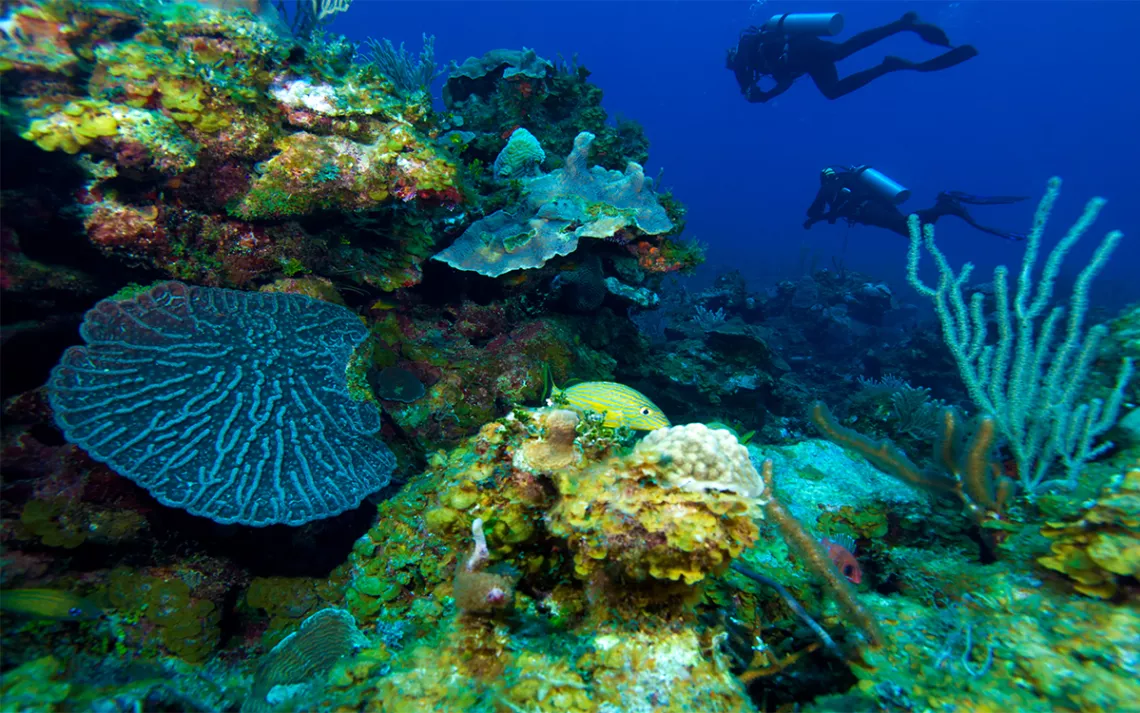Cuba’s Accidental Offshore Eden
Pristine reefs, due to the U.S. embargo

Photo by Rostislavv/iStock
Dotted with crater-size potholes, the highway extending the length of Cuba is mostly empty, with the exception of the occasional hitchhiker, horse-drawn carriage, or farmer clearing weeds from the edge of his land with a machete. We pass a few military vehicles and a taxi or two, but for the most part, says our driver, “it’s too expensive for Cubans to drive.” The high cost of gas coupled with limited access to cars and bad roads makes the journey between towns eerily quiet.
We’re headed to a chain of beaches about 2.5 hours beyond bustling Havana. Tucked inside the Ciénaga de Zapata National Park, the azure waters and sugar-white sands are known less as an ocean sanctuary and more as the site of the failed Bay of Pigs invasion, led by CIA-sponsored paramilitaries in 1961. Aged propaganda billboards line the dirt roads approaching the beaches as a reminder of the failed coup attempt.
Arriving at Punta Perdiz beach, scuba divers and snorkelers scurry to the edge of the water. It’s bright and clear, even as the afternoon current pushes hard against the rocky shore. Elkhorn and staghorn coral are easy to spot, as are colonies of brain coral with schools of fluorescent fish zigzagging in between. Cuba’s blissfully undeveloped beaches are a big draw for Canadian and European tourists, who flock to the island to enjoy its tropical temperatures regulated by cooling trade winds.
That lack of development isn’t entirely accidental. Twenty-three percent of the waters surrounding the island were declared marine sanctuaries to protect and boost ecotourism and fishing, the two industries that support many Cubans living by the shore. But the bigger factor is the U.S. economic embargo, which has shielded much of the island from the coastal development that’s prevalent along the Florida coastlines and in much of the Caribbean.
Cuban waters are also free of the chemical pollution that can cause algae blooms, says Jorge Alberto Angulo-Valdes, a visiting research scholar at the School of Natural Resources and Environment at the University of Florida and the former director of the Center for Marine Research at the University of Havana. “After the collapse of the Soviet Union in 1991, Cuba no longer had access to fertilizers and chemicals,” he says. “It forced us into organic agriculture.” Even Havana’s famous Malecón is now lined with Cubans sipping rum and dipping their fishing poles into the harbor, once devoid of fish.
In recent years, the National Oceanic and Atmospheric Administration and Cuba’s Centro Nacional de Áreas Protegidas have worked together to research the coral reefs in Cuba’s Guanahacabibes National Park as well as Florida’s Dry Tortugas and Biscayne National Parks. Their reef ecosystems are similar, says Angulo-Valdes, so it’s an opportunity to look at human impact, because Dry Tortugas and Biscayne National Parks experience much more human activity, as well as the effects of agrochemicals. Although he has not worked on the most recent coral-research partnership, Angulo-Valdes says that scientists witnessed species in Cuban reefs that they hadn’t seen in the United States in years, if ever.
The Trump administration recently announced that it will tighten restrictions on traveling to Cuba. Even so, says Angulo-Valdes, scientific partnerships between the countries are more important than ever. “If Cuba protects its waters, then the U.S. can benefit from these resources,” he says. “Sea turtles, manatees, and sharks tagged in U.S. waters have been found in Cuba, and fish, like snapper, that spawn in Cuba, make their way to U.S. waters and contribute to both recreational and commercial fishing.”
Angulo-Valdes worries that as the Communist country opens up to a more conventional tourist industry, its marine protections will falter. He hopes that the country will go with the nature-oriented tourism that has helped Costa Rica thrive. A good example is the pioneering eco-village of Las Terrazas, a day trip from Havana. After a reforestation project in 1968, the tiny town transitioned into the sustainable community that today draws adventure tourists to sample fresh coffee, explore local art, and enjoy a canopy tour across the delicate Unesco Biosphere Reserve. It’s the direction in which Angulo-Valdes hopes tourism and the nation as a whole will move as this isolated island continues to open up to the world.
 The Magazine of The Sierra Club
The Magazine of The Sierra Club



